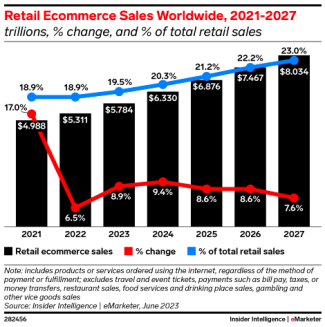The world of e-commerce is continuously evolving, driven by technological advancements, changing consumer behavior, and emerging market trends. Staying ahead of the curve is crucial for sustained success, and as we approach 2024, it’s essential for e-commerce brands to strategically plan their investments.
In this article, we will explore the current state of e-commerce, examine what we can expect in 2024, delve into the top trends, discuss key areas of investment, and explore how a headless architecture can enable each of these strategies.
The Current State of E-commerce
Before delving into the future, let’s take stock of how the e-commerce landscape currently lies. The industry has experienced exponential growth in recent years, with global e-commerce sales expected to reach $5.9 trillion in 2023. This growth has been fueled by technological advancements, changing consumer behavior, and global connectivity.
But after experiencing a period of rapid growth and acceleration, e-commerce growth has taken on a more moderate pace. In 2023 the sales growth of retail e-commerce will only increase by 8.9%. This is a significant decrease compared to the growth rates of 26.7% in 2020 and 16.8% in 2021, but it is up in 2022, which came in with 7.1% growth.
In the US alone, e-commerce revenue is expected to surpass $1 trillion in 2024, accounting for nearly 20% of all retail sales, indicating the continued significance of e-commerce in the retail sector.

What we can expect for e-commerce in 2024
Top e-commerce trends and priorities in 2024
In the fast-paced world of e-commerce, staying ahead means embracing the latest trends and aligning your strategies with these emerging priorities.
AI, AR/VR, blockchain
Artificial intelligence (AI), augmented reality (AR), and blockchain technology are poised to revolutionize the e-commerce experience. AI-powered personalization engines will curate tailored product recommendations and marketing messages, while AR will enable virtual try-on features for clothing and furniture. Blockchain, with its secure and transparent nature, will enhance payment security and provide traceability for products.
Strategy: Invest in AI, AR, and blockchain solutions to enhance customer experiences, improve operational efficiency, and gain a competitive edge.
Personalization
Data-driven personalization will continue to be a top priority in 2024. Businesses should leverage customer data to deliver relevant product recommendations, tailored marketing messages, and customized shopping experiences. This personalized approach will foster customer loyalty and drive conversions.
Strategy: Invest in data analytics tools and customer data platforms to gather, analyze, and utilize customer data effectively for personalization strategies.
Quick commerce
Q-commerce, characterized by ultra-fast deliveries and instant gratification, is gaining traction among consumers. Businesses should invest in Quick-commerce capabilities to meet this demand, including optimizing supply chains, partnering with local delivery providers, and leveraging hyperlocal fulfillment centers.
Strategy: Invest in Q-commerce infrastructure, such as dark stores and last-mile delivery solutions, to provide rapid deliveries and meet customer expectations.
Social commerce
In 2024, social media as a sales platform is expected to soar, reaching $2.9 trillion by 2026, providing businesses with new opportunities to reach and engage customers. This trend underscores the growing influence of social media platforms in driving e-commerce sales and customer engagement.
Strategy: Establish a strong social media presence, collaborate with influencers, and implement social commerce features to seamlessly integrate social media into their e-commerce journey.
Multi-store integration
Multi-store selling is becoming increasingly common, with brands expanding their presence across multiple platforms outside of their own website. Businesses should streamline multi-store management to ensure consistent branding, product information, and customer experiences across all platforms.
Strategy: Implement multi-store management tools to centralize inventory management, order processing, and customer data across all platforms.
Multi-media experience
Video content, interactive elements, and sensory experiences are captivating the attention of online shoppers. Businesses should utilize these multimedia elements to engage customers, showcase products, and drive conversions.
Strategy: Businesses should invest in video production, interactive product demos, and sensory experiences to create immersive and engaging shopping experiences.
Sustainable e-commerce & CSR
As consumers become more environmentally conscious, the e-commerce industry iswill continue to prioritize sustainability in 2024. Businesses anticipate focusing on providing eco-friendly options and adopting environmentally responsible practices to meet customer expectations.
Strategy: Implement sustainable practices, such as eco-friendly packaging, carbon offsetting, and transparent supply chains, to appeal to environmentally conscious consumers.
Omnichannel commerce
Omnichannel commerce breaks down silos between online and offline channels, providing seamless customer journeys across all touchpoints. Businesses should integrate their e-commerce platforms with physical stores, mobile apps, and social media to create a unified customer experience.
Strategy: Implement omnichannel strategies, such as in-store pick-up, mobile checkout, and personalized product recommendations, to bridge the gap between online and offline experiences.
B2B commerce
Forrester predicts that B2B e-commerce sales will exceed $2.3 trillion in 2024, with further growth in the years that follow. This trend reflects the increasing adoption of online purchasing by businesses, particularly as younger generations enter the workforce.
Strategy: Expand your reach in the B2B market, by offering a tailored B2B e-commerce solution.
Key areas of investment in eCommerce in 2024
Headless Architectures and Composable Commerce: Investing in headless architectures allows for greater flexibility and scalability, enabling seamless integration with various platforms and best-of-breed technologies. Composable commerce further empowers businesses to adapt quickly to changing market dynamics.
Technology and Innovation: Constant innovation is the key to staying competitive. Investing in cutting-edge technologies ensures that your businesse can adapt to changing consumer behaviors and market trends.
Online Customer Experience: A seamless and personalized online customer experience is non-negotiable. Investing in user-friendly interfaces, personalization algorithms, and responsive design is paramount.
Mobile commerce is projected to continue its growth trajectory in 2024, with sales from mobile devices expected to exceed $600 billion. This highlights the increasing importance of optimizing e-commerce websites for mobile devices.
Shipping and Fulfillment: Efficient and reliable shipping and fulfillment processes are crucial for customer satisfaction. Investment in logistics technology and partnerships can streamline these operations and reduce costs.
Privacy and Security: With increasing concerns about data privacy, investing in robust security measures and compliance with regulations is essential to build and maintain customer trust and comply with privacy regulations.
Marketing and Sales Technology: Effective marketing strategies rely on the right technology. Investments in data-driven marketing tools, automation, and analytics platforms can optimize marketing efforts and drive sales.
Payment and Financing: Offering diverse and secure payment options, along with flexible financing solutions such as including alternative payment methods and buy-now-pay-later, can contribute to increased conversion rates.
Customer Behavior: Understanding and predicting customer behavior is a continuous challenge. Investments in analytics and AI-driven insights can provide valuable data for informed decision-making and tailored strategies to encourage growth.
How a headless architecture can enable each of the 2024 top e-commerce trends
A headless architecture empowers businesses to adapt swiftly to emerging trends and technologies in the dynamic e-commerce landscape. Its decoupled structure enables seamless integration with cutting-edge advancements such as AI algorithms, immersive multimedia experiences, and social commerce platforms. This adaptability positions businesses at the forefront of e-commerce innovation, allowing them to deliver exceptional customer experiences and stay ahead of the competition.
Why it’s important to stay ahead of the curve
Staying ahead of the competition is crucial to thrive in the digital landscape. By investing in the latest trends and technologies, businesses can gain a competitive edge, enhance customer experiences, and achieve sustainable growth. Here are the key benefits of staying ahead:
1. Forecast new developments: Businesses that stay ahead of the curve are better equipped to anticipate emerging trends, enabling proactive rather than reactive strategies.
By 2026, the global e-commerce market is expected to exceed $8.1 trillion. This underlines the long-term potential of e-commerce as a valuable investment
2. Become a market leader: By embracing new trends and technologies, businesses can differentiate themselves from competitors and establish themselves as industry leaders.
3. Identify new opportunities: Staying informed about industry trends opens up new business opportunities: partnerships, products and services, untapped customer segments.
4. Business Growth: Ultimately, strategically planning in order to stay ahead of the curve will contribute to sustained business growth and improve profitablity, even in today’s volatile market.
Navigating a future with slower growth and higher costs
In the rapidly evolving world of e-commerce, strategic planning is the compass that guides businesses through uncharted territories. A business that can successfully navigate these changes will reap the rewards of increased customer engagement, improved operational efficiency, and sustainable growth. By investing in the right technologies, adopting emerging trends, and fostering a culture of innovation, e-commerce brands can position themselves for success in 2024 and beyond.


